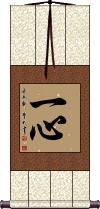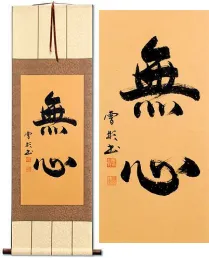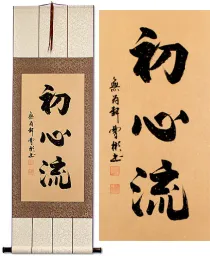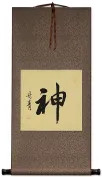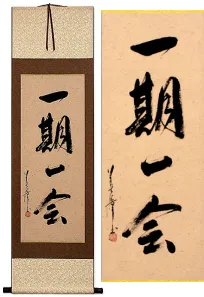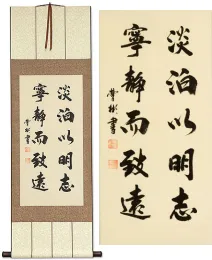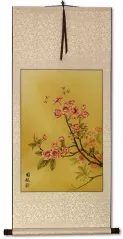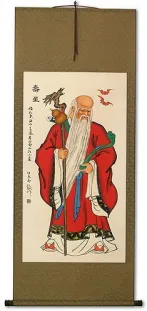Many custom options...
And formats...

One Mind in Chinese / Japanese...
Buy an One Mind calligraphy wall scroll here!
Personalize your custom “One Mind” project by clicking the button next to your favorite “One Mind” title below...
One Heart / One Mind / Heart and Soul
一心 literally reads as “one heart” in Chinese, Japanese Kanji, and old Korean Hanja.
Colloquially or figuratively, it means: wholeheartedly; heart and soul; of one mind; wholeheartedness; one's whole heart; with the whole mind or heart; one mind in heart.
I'm not kidding, all of those came right from the dictionary for this one title.
In Buddhism, this can refer to the bhūtatathatā, or the whole of things; the universe as one mind, or a spiritual unity.
In Japanese, this can be the female given name, Hitomi.
One Mind / Unity
和合 means to blend, unite, or be of one mind.
和合 is usually used as a Buddhist term. It can also be defined as harmony, concord, agreement, unity, union, and harmonize/harmonization.
Work Together with One Mind
This in-stock artwork might be what you are looking for, and ships right away...
Gallery Price: $202.00
Your Price: $111.88
Gallery Price: $200.00
Your Price: $118.88
Gallery Price: $202.00
Your Price: $111.88
Gallery Price: $72.00
Your Price: $39.88
Gallery Price: $340.00
Your Price: $188.77
Gallery Price: $198.00
Your Price: $109.88
Not the results for one mind that you were looking for?
Below are some entries from our dictionary that may match your one mind search...
| Characters If shown, 2nd row is Simp. Chinese |
Pronunciation Romanization |
Simple Dictionary Definition |
定 see styles |
dìng ding4 ting jou / jo じょう |
More info & calligraphy: Samadhi(1) (See 案の定・あんのじょう) certainty; reality; actuality; (prefix noun) (2) (See 定宿) regular; permanent; (3) {Buddh} (See 三昧・さんまい・1,禅定・ぜんじょう・1) samadhi (state of intense concentration achieved through meditation); (given name) Yasushi To fix, settle. samādhi. 'Composing the mind'; 'intent contemplation'; 'perfect absorption of thought into the one object of meditation.' M. W. Abstract meditation, the mind fixed in one direction, or field. (1) 散定 scattered or general meditation (in the world of desire). (2) 禪定 abstract meditation (in the realms of form and beyond form). It is also one of the five attributes of the dharmakāya 法身, i. e. an internal state of imperturbability or tranquility, exempt from all external sensations, 超受陰; cf. 三摩提. |
心 see styles |
xīn xin1 hsin shin しん |
More info & calligraphy: Heart / Mind / Spirit(1) (See 心・こころ・1) heart; mind; spirit; vitality; inner strength; (2) bottom of one's heart; core (of one's character); nature; (3) (usu. written as 芯) (See 芯・2) centre; center; core; heart; (4) (See 心臓・1) heart (organ); (5) {astron} (See 二十八宿) Chinese "Heart" constellation (one of the 28 mansions); (6) (archaism) (child. language) friend; (given name) Haato hṛd, hṛdaya 汗栗太 (or 汗栗馱); 紀哩馱 the heart, mind, soul; citta 質多 the heart as the seat of thought or intelligence. In both senses the heart is likened to a lotus. There are various definitions, of which the following are six instances: (1) 肉團心 hṛd, the physical heart of sentient or nonsentient living beings, e. g. men, trees, etc. (2) 集起心 citta, the ālayavijñāna, or totality of mind, and the source of all mental activity. (3) 思量心 manas, the thinking and calculating mind; (4) 緣慮心; 了別心; 慮知心; citta; the discriminating mind; (5) 堅實心 the bhūtatathatā mind, or the permanent mind; (6) 積聚精要心 the mind essence of the sutras. |
法 see styles |
fǎ fa3 fa hou / ho ほう |
More info & calligraphy: Dharma / The Law(n,n-suf) (1) law; act; principle; (n,n-suf) (2) method; (n,n-suf) (3) {gramm} mood; (n,n-suf) (4) {Buddh} dharma; law; (female given name) Minori Dharma, 達磨; 曇無 (or 曇摩); 達摩 (or 達謨) Law, truth, religion, thing, anything Buddhist. Dharma is 'that which is held fast or kept, ordinance, statute, law, usage, practice, custom'; 'duty'; 'right'; 'proper'; 'morality'; 'character'. M. W. It is used in the sense of 一切 all things, or anything small or great, visible or invisible, real or unreal, affairs, truth, principle, method, concrete things, abstract ideas, etc. Dharma is described as that which has entity and bears its own attributes. It connotes Buddhism as the perfect religion; it also has the second place in the triratna 佛法僧, and in the sense of 法身 dharmakāya it approaches the Western idea of 'spiritual'. It is also one of the six media of sensation, i. e. the thing or object in relation to mind, v. 六塵. |
禪 禅 see styles |
shàn shan4 shan yuzuri ゆずり |
More info & calligraphy: Zen / Chan / Meditation(out-dated kanji) (1) (Buddhist term) dhyana (profound meditation); (2) (abbreviation) Zen (Buddhism); (surname) Yuzuri To level a place for an altar, to sacrifice to the hills and fountains; to abdicate. Adopted by Buddhists for dhyāna, 禪 or 禪那, i.e. meditation, abstraction, trance. dhyāna is 'meditation, thought, reflection, especially profound and abstract religious contemplation'. M.W. It was intp. as 'getting rid of evil', etc., later as 靜慮 quiet meditation. It is a form of 定, but that word is more closely allied with samādhi, cf. 禪定. The term also connotes Buddhism and Buddhist things in general, but has special application to the 禪宗 q.v. It is one of the six pāramitās, cf. 波. There are numerous methods and subjects of meditation. The eighteen brahmalokas are divided into four dhyāna regions 'corresponding to certain frames of mind where individuals might be reborn in strict accordance with their spiritual state'. The first three are the first dhyāna, the second three the second dhyāna, the third three the third dhyāna, and the remaining nine the fourth dhyāna. See Eitel. According to Childers' Pali Dictionary, 'The four jhānas are four stages of mystic meditation, whereby the believer's mind is purged from all earthly emotions, and detached as it were from his body, which remains plunged in a profound trance.' Seated cross-legged, the practiser 'concentrates his mind upon a single thought. Gradually his soul becomes filled with a supernatural ecstasy and serenity', his mind still reasoning: this is the first jhāna. Concentrating his mind on the same subject, he frees it from reasoning, the ecstasy and serenity remaining, which is the second jhāna. Then he divests himself of ecstasy, reaching the third stage of serenity. Lastly, in the fourth stage the mind becomes indifferent to all emotions, being exalted above them and purified. There are differences in the Mahāyāna methods, but similarity of aim. |
空 see styles |
kòng kong4 k`ung kung kuu / ku くう |
More info & calligraphy: Sky / Ether / Void / Emptiness / Unreality(1) empty air; sky; (2) {Buddh} shunyata (the lack of an immutable intrinsic nature within any phenomenon); emptiness; (3) (abbreviation) (See 空軍) air force; (noun or adjectival noun) (4) fruitlessness; meaninglessness; (noun or adjectival noun) (5) (See 五大・1) void (one of the five elements); (can be adjective with の) (6) {math} empty (e.g. set); (female given name) Ron śūnya, empty, void, hollow, vacant, nonexistent. śūnyatā, 舜若多, vacuity, voidness, emptiness, non-existence, immateriality, perhaps spirituality, unreality, the false or illusory nature of all existence, the seeming 假 being unreal. The doctrine that all phenomena and the ego have no reality, but are composed of a certain number of skandhas or elements, which disintegrate. The void, the sky, space. The universal, the absolute, complete abstraction without relativity. There are classifications into 2, 3, 4, 6, 7, 11, 13, 16, and 18 categories. The doctrine is that all things are compounds, or unstable organisms, possessing no self-essence, i.e. are dependent, or caused, come into existence only to perish. The underlying reality, the principle of eternal relativity, or non-infinity, i.e. śūnya, permeates all phenomena making possible their evolution. From this doctrine the Yogācārya school developed the idea of the permanent reality, which is Essence of Mind, the unknowable noumenon behind all phenomena, the entity void of ideas and phenomena, neither matter nor mind, but the root of both. |
一心 see styles |
yī xīn yi1 xin1 i hsin isshin いっしん |
More info & calligraphy: One Heart / One Mind / Heart and Soul(adv,n) (1) one mind; (adv,n) (2) (See 一心に) wholeheartedness; one's whole heart; (female given name) Hitomi With the whole mind or heart; one mind of heart; also the bhūtatathatā, or the whole of things; the universe as one mind, or a spiritual unity. |
三昧 see styles |
sān mèi san1 mei4 san mei sanmai; zanmai さんまい; ざんまい |
More info & calligraphy: Samadhi(1) (さんまい only) {Buddh} samadhi (state of intense concentration achieved through meditation) (san:); (suffix noun) (2) (usu. ざんまい) being immersed in; being absorbed in; indulging in; doing to one's heart's content; (suffix noun) (3) (usu. ざんまい) prone to; apt to; (given name) Sanmai (三昧地) Samādhi, "putting together, composing the mind, intent contemplation, perfect absorption, union of the meditator with the object of meditation." (M. W.) Also 三摩地 (三摩提, 三摩帝, 三摩底). Interpreted by 定 or 正定, the mind fixed and undisturbed; by 正受 correct sensation of the object contemplated; by 調直定 ordering and fixing the mind; by 正心行處 the condition when the motions of the mind are steadied and harmonized with the object; by 息慮凝心 the cessation of distraction and the fixation of the mind; by 等持 the mind held in equilibrium; by 奢摩他, i.e. 止息 to stay the breathing. It is described as concentration of the mind (upon an object). The aim is 解脫, mukti, deliverance from all the trammels of life, the bondage of the passions and reincarnations. It may pass from abstraction to ecstasy, or rapture, or trance. Dhyāna 定 represents a simpler form of contemplation; samāpatti 三摩鉢底 a stage further advanced; and samādhi the highest stage of the Buddhist equivalent for Yoga, though Yoga is considered by some as a Buddhist development differing from samādhi. The 翻譯名義 says: 思專 when the mind has been concentrated, then 志一不分 the will is undivided; when 想寂 active thought has been put to rest, then 氣虛神朗 the material becomes etherealized and the spirit liberated, on which 智 knowledge, or the power to know, has free course, and there is no mystery into which it cannot probe. Cf. 智度論 5, 20, 23, 28; 止觀 2; 大乘義章 2, 9, 1 3, 20, etc. There are numerous kinds and degrees of samādhi. |
初心 see styles |
chū xīn chu1 xin1 ch`u hsin chu hsin shoshin しょしん |
More info & calligraphy: Mind of the Beginner(1) one's original intention; one's initial enthusiasm; (n,adj-no,adj-na) (2) inexperience; naivety; greenness; (female given name) Ubu The initial resolve or mind of the novice. |
和合 see styles |
hé hé he2 he2 ho ho wagou / wago わごう |
More info & calligraphy: One Mind / Unity(n,vs,vi) harmony; concord; agreement; unity; union; (place-name, surname) Wagou To blend, unite, be of one mind, harmonize. |
安心 see styles |
ān xīn an1 xin1 an hsin anjin あんじん |
More info & calligraphy: Peaceful Heart / Peace of Mind / Calm Mind{Buddh} obtaining peace of mind through faith or ascetic practice; (female given name) Anshin To quiet the heart, or mind; be at rest. |
本心 see styles |
běn xīn ben3 xin1 pen hsin honshin ほんしん |
More info & calligraphy: The Original MindThe original heart, or mind; one's own heart. |
決心 决心 see styles |
jué xīn jue2 xin1 chüeh hsin kesshin けっしん |
More info & calligraphy: Determination(noun, transitive verb) determination; resolution |
知識 知识 see styles |
zhī shi zhi1 shi5 chih shih tomoshiki ともしき |
More info & calligraphy: Perception of Knowledgeknowledge; information; (surname) Tomoshiki (1) To know and perceive, perception, knowledge. (2) A friend, an intimate. (3) The false ideas produced in the mind by common, or unenlightened knowledge; one of the 五識 in 起信論. |
菩薩 菩萨 see styles |
pú sà pu2 sa4 p`u sa pu sa bosatsu(p); bosachi(ok) ぼさつ(P); ぼさち(ok) |
More info & calligraphy: Bodhisattva(n,n-suf) (1) {Buddh} bodhisattva; one who has reached enlightenment but vows to save all beings before becoming a buddha; (n,n-suf) (2) High Monk (title bestowed by the imperial court); (n,n-suf) (3) (See 本地垂迹説) title bestowed to Shinto kami in manifestation theory; (surname) Mizoro bodhisattva, cf. 菩提薩埵. While the idea is not foreign to Hīnayāna, its extension of meaning is one of the chief marks of Mahāyāna. 'The Bodhisattva is indeed the characteristic feature of the Mahāyāna.' Keith. According to Mahāyāna the Hinayanists, i.e. the śrāvaka and pratyekabuddha, seek their own salvation, while the bodhisattva's aim is the salvation of others and of all. The earlier intp. of bodhisattva was 大道心衆生 all beings with mind for the truth; later it became 大覺有情 conscious beings of or for the great intelligence, or enlightenment. It is also intp. in terms of leadership, heroism, etc. In general it is a Mahayanist seeking Buddhahood, but seeking it altruistically; whether monk or layman, he seeks enlightenment to enlighten others, and he will sacrifice himself to save others; he is devoid of egoism and devoted to helping others. All conscious beings having the Buddha-nature are natural bodhisattvas, but require to undergo development. The mahāsattva is sufficiently advanced to become a Buddha and enter nirvāṇa, but according to his vow he remains in the realm of incarnation to save all conscious beings. A monk should enter on the arduous course of discipline which leads to Bodhisattvahood and Buddhahood. |
銘記 铭记 see styles |
míng jì ming2 ji4 ming chi meiki / meki めいき |
More info & calligraphy: Remember(noun, transitive verb) keep in mind; take note of; remember |
奢摩他 see styles |
shē mó tā she1 mo2 ta1 she mo t`a she mo ta shamata |
More info & calligraphy: Samatha |
平常心 see styles |
píng cháng xīn ping2 chang2 xin1 p`ing ch`ang hsin ping chang hsin heijoushin / hejoshin へいじょうしん |
More info & calligraphy: Heijoshin / Presence of Mindone's self-possession; one's presence of mind ordinary mind |
一味同心 see styles |
ichimidoushin / ichimidoshin いちみどうしん |
More info & calligraphy: Work Together with One Mind |
眉を開く see styles |
mayuohiraku まゆをひらく |
More info & calligraphy: Let It Be / Be Relieved |
乗り換える see styles |
norikaeru のりかえる |
More info & calligraphy: Move On / Change Way of Thinking |
懷 怀 see styles |
huái huai2 huai kai ふところ |
bosom; heart; mind; to think of; to harbor in one's mind; to conceive (a child) (out-dated kanji) (1) bosom; bust; (2) (breast) pocket; purse; handbag To carry in the bosom, mind, or heart; to embrace, cherish; the bosom. |
捨 舍 see styles |
shě she3 she sha しゃ |
to give up; to abandon; to give alms {Buddh} equanimity; upeksa; upekkha upekṣā, neglect, indifference, abandoning, M.W. To relinquish, renounce, abandon, reject, give. One of the chief Buddhist virtues, that of renunciation, leading to a state of "indifference without pleasure or pain" (Keith), or independence of both. v. 舍. It is defined as the mind 平等 in equilibrium, i.e. above the distinction of things or persons, of self or others; indifferent, having abandoned the world and all things and having no affections or desires. One of the seven bodhyaṅgas. Translit. sa, śa, s(r). |
有 see styles |
yǒu you3 yu yuu / yu ゆう |
to have; there is; (bound form) having; with; -ful; -ed; -al (as in 有意[you3yi4] intentional) (1) existence; (n,n-pref) (2) possession; having; (3) (abbreviation) (in company names; written as (有)) (See 有限会社) limited company; (personal name) Yumi bhāva: that which exists, the existing, existence; to have, possess, be. It is defined as (1) the opposite of 無 wu and 空 kong the non-existent; (2) one of the twelve nidānas, existence; the condition which, considered as cause, produces effect; (3) effect, the consequence of cause; (4) anything that can be relied upon in the visible or invisible realm. It means any state which lies between birth and death, or beginning and end. There are numerous categories— 3, 4, 7, 9, 18, 25, and 29. The 三有 are the 三界 trailokya, i. e. 欲, 色 and 無色界 the realms of desire, of form, and of non-form, all of them realms of mortality; another three are 本有 the present body and mind, or existence, 當有 the future ditto, 中有 the intermediate ditto. Other definitions give the different forms or modes of existence. |
止 see styles |
zhǐ zhi3 chih tomeru とめる |
to stop; to prohibit; until; only (given name) Tomeru To stop, halt, cease; one of the seven definitions of 禪定 dhyāna described as 奢摩他 śamatha or 三摩地 samādhi; it is defined as 靜息動心 silencing, or putting to rest the active mind, or auto-hypnosis; also 心定止於一處 the mind centred, lit. the mind steadily fixed on one place, or in one position. It differs from 觀 which observes, examines, sifts evidence; 止 has to do with 拂妄 getting rid of distraction for moral ends; it is abstraction, rather than contemplation; see 止觀 In practice there are three methods of attaining such abstraction: (a) by fixing the mind on the nose, navel, etc.; (b) by stopping every thought as it arises; (c) by dwelling on the thought that nothing exists of itself, but from a preceding cause. |
肚 see styles |
dù du4 tu hara はら |
belly (1) abdomen; belly; stomach; (2) womb; (3) one's mind; one's real intentions; one's true motive; (4) courage; nerve; willpower; (5) generosity; magnanimity; (6) feelings; emotions; (7) wide middle part; bulging part; (8) inside; interior; inner part; (9) (physics) anti-node; (suf,ctr) (10) counter for hard roe; (11) counter for containers with bulging middles (pots, vases, etc.) |
腹 see styles |
fù fu4 fu fuku はら |
abdomen; stomach; belly (1) abdomen; belly; stomach; (2) womb; (3) one's mind; one's real intentions; one's true motive; (4) courage; nerve; willpower; (5) generosity; magnanimity; (6) feelings; emotions; (7) wide middle part; bulging part; (8) inside; interior; inner part; (9) (physics) anti-node; (suf,ctr) (10) counter for hard roe; (11) counter for containers with bulging middles (pots, vases, etc.) The belly. |
行 see styles |
xíng xing2 hsing kou / ko こう |
to walk; to go; to travel; a visit; temporary; makeshift; current; in circulation; to do; to perform; capable; competent; effective; all right; OK!; will do; behavior; conduct; Taiwan pr. [xing4] for the behavior-conduct sense (n,n-suf) (1) going; travelling; traveling; journey; trip; (2) act; action; (suffix noun) (3) bank; (counter) (4) counter for banks; (counter) (5) counter for groups or parties of people; (6) type of classical Chinese verse (usu. an epic from the Tang period onwards); (7) (hist) shopping district (of similar merchants; in the Sui and Tang periods); (8) (hist) merchants' guild (in the Tang period); (female given name) Yukue Go; act; do; perform; action; conduct; functioning; the deed; whatever is done by mind, mouth, or body, i.e. in thought, word, or deed. It is used for ayana, going, road, course; a march, a division of time equal to six months; also for saṁskāra, form, operation, perfecting, as one of the twelve nidānas, similar to karma, action, work, deed, especially moral action, cf. 業. |
識 识 see styles |
zhì zhi4 chih shiki しき |
to record; to write a footnote (1) acquaintanceship; (2) {Buddh} vijnana; consciousness; (3) (after a signature) written by...; (personal name) Tsuguhide vijñāna, "the art of distinguishing, or perceiving, or recognizing, discerning, understanding, comprehending, distinction, intelligence, knowledge, science, learning . . . wisdom." M.W. parijñāna, "perception, thorough knowledge," etc. M.W. It is intp. by 心 the mind, mental discernment, perception, in contrast with the object discerned; also by 了別 understanding and discrimination. There are classifications of 一識 that all things are the one mind, or are metaphysical; 二識 q. v. discriminating the ālaya-vijñāna or primal undivided condition from the mano-vijñāna or that of discrimination; 三識 in the Laṅkāvatāra Sutra, fundamental, manifested and discriminate; 五識 q.v. in the 起信論, i.e. 業, 轉, 現, 知, and 相續識; 六識 the perceptions and discernings of the six organs of sense; also of 8, 9, 10, and 11 識. The most important is the eight of the 起信論, i.e. the perceptions of the six organs of sense, eye, ear, nose, tongue, body (or touch), and mind, together with manas, intp. as 意識 the consciousness of the previous moment, on which the other six depend; the eighth is the ālaya-vijñāna, v. 阿賴耶, in which is contained the seed or stock of all phenomena and which 無沒 loses none, or nothing, is indestructible; a substitute for the seventh is ādāna 'receiving' of the 唯識, which is intp. as 無解 undiscriminated, or indefinite perception; there is a difference of view between the 相 and the 性 schools in regard to the seventh and eight 識; and the latter school add a ninth called the amala, or pure vijñāna, i.e. the non-phenomenal 眞如識. The esoterics add that all phenomena are mental and all things are the one mind, hence the one mind is 無量識 unlimited mind or knowledge, every kind of knowledge, or omniscience. vijñāna is one of the twelve nidānas.; Ālaya-vijñāna and mano-vijñāna; i. e. 阿梨耶 | and 分別事 |; v. 識. |
護 护 see styles |
hù hu4 hu mori もり |
to protect (surname) Mori To protect, guard, succour.; The two protectors: the inner, oneself, by studying and following the Law; the outer, those who supply what is needful for one's body and mind, e. g. supporters. |
閃 闪 see styles |
shǎn shan3 shan sen せん |
to dodge; to duck out of the way; to beat it; shaken (by a fall); to sprain; to pull a muscle; lightning; spark; a flash; to flash (across one's mind); to leave behind; (Internet slang) (of a display of affection) "dazzlingly" saccharine (female given name) Sen Flash; get out of the way. |
Click here for more one mind results from our dictionary
The following table may be helpful for those studying Chinese or Japanese...
| Title | Characters | Romaji (Romanized Japanese) | Various forms of Romanized Chinese | |
| One Heart One Mind Heart and Soul | 一心 | isshin / ishin | yī shì dài yi1 shi4 dai4 yi shi dai yishidai | i shih tai ishihtai |
| One Mind Unity | 和合 | wagou / wago wago / wago | hé hé / he2 he2 / he he / hehe | ho ho / hoho |
| Work Together with One Mind | 一味同心 | ichi mi dou shin ichimidoushin ichi mi do shin | ||
Successful Chinese Character and Japanese Kanji calligraphy searches within the last few hours...
